Abstract
In animals and humans, estrogens are able to induce cancer in susceptible target organs, but the mechanism(s) of estrogen-induced carcinogenesis has not been elucidated. A well-known animal model is the development of renal carcinoma in estrogen-treated Syrian hamsters. Previous work demonstrated the presence of covalent DNA addition products (adducts) in premalignant kidneys of hamsters exposed to the synthetic estrogen, diethylstilbestrol, a known human carcinogen. In the present study, the natural hormone, 17 beta-estradiol, and several synthetic steroid and stilbene estrogens were examined by a 32P-postlabeling assay for their capacity to cause covalent DNA alterations in hamster kidney. Chronic exposure to each of the estrogens tested led to the gradual formation of five chromatographically distinct unusual nucleotides specifically in kidney DNA. Irrespective of the estrogen used, chromatograms exhibited identical mobilities of each of these adducts in seven different systems on PEI-cellulose anion-exchange TLC, in three different conditions on reversed-phase TLC, and in one system on silica gel partition TLC. Therefore, the DNA adducts observed did not contain moieties derived from the structurally diverse estrogens. It is concluded that each of the estrogens induced the binding of the same unknown endogenous compound (or compounds) to target tissue DNA. This novel property of estrogens is postulated to play a key role in hormone-induced malignancy.
Full text
PDF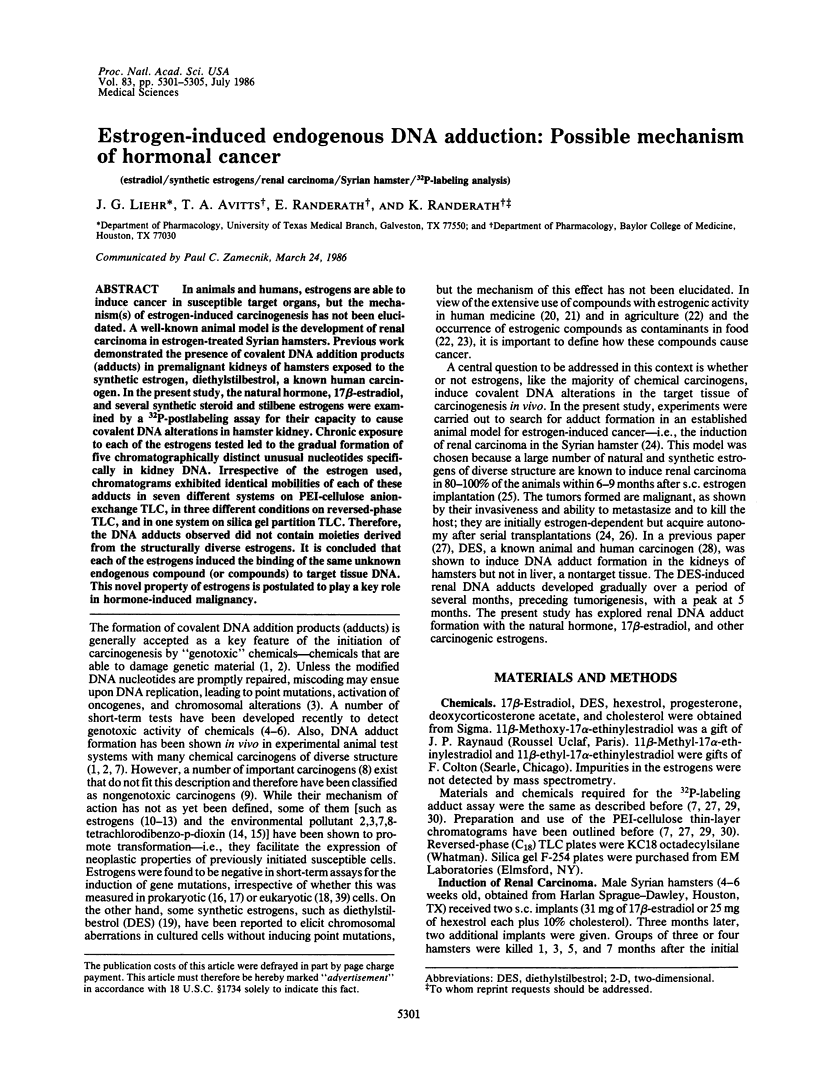
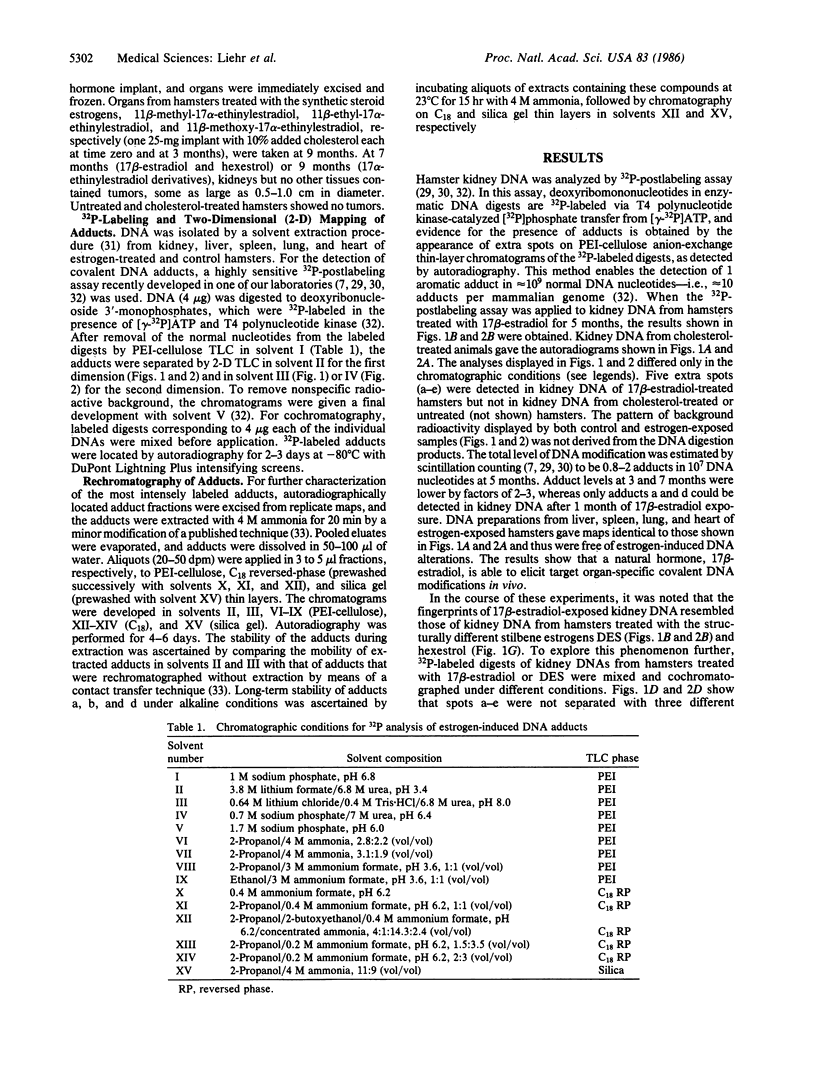
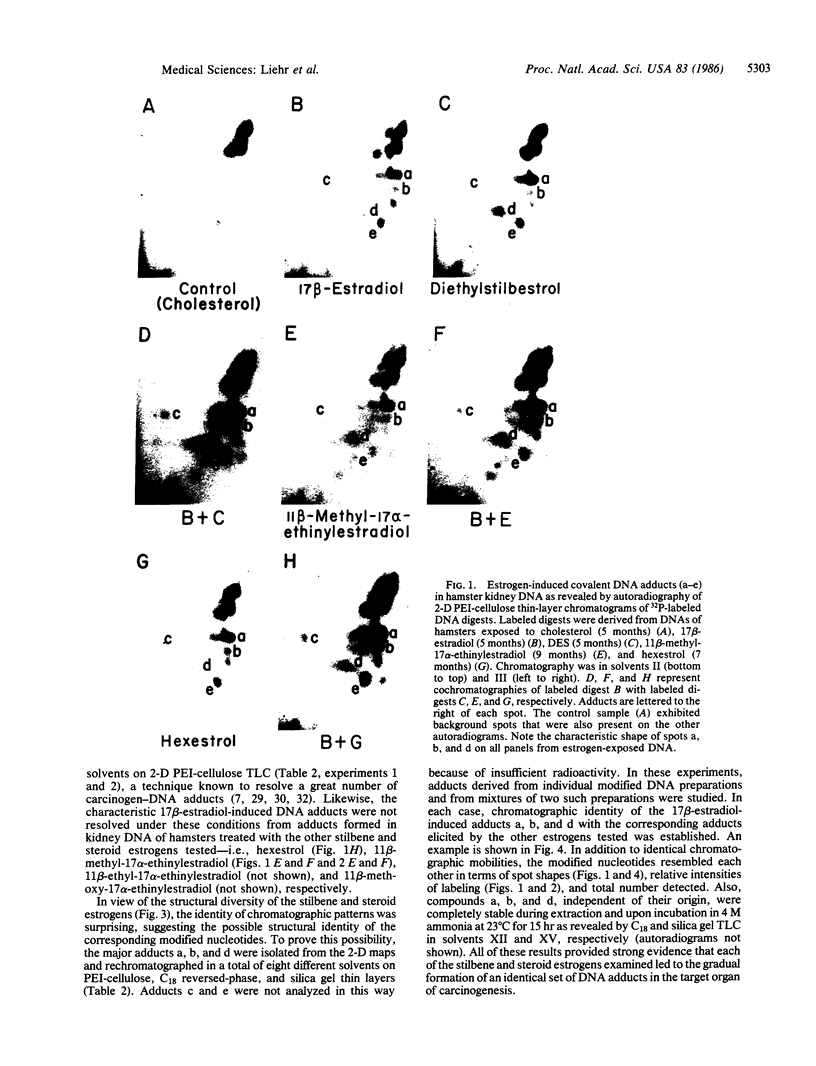
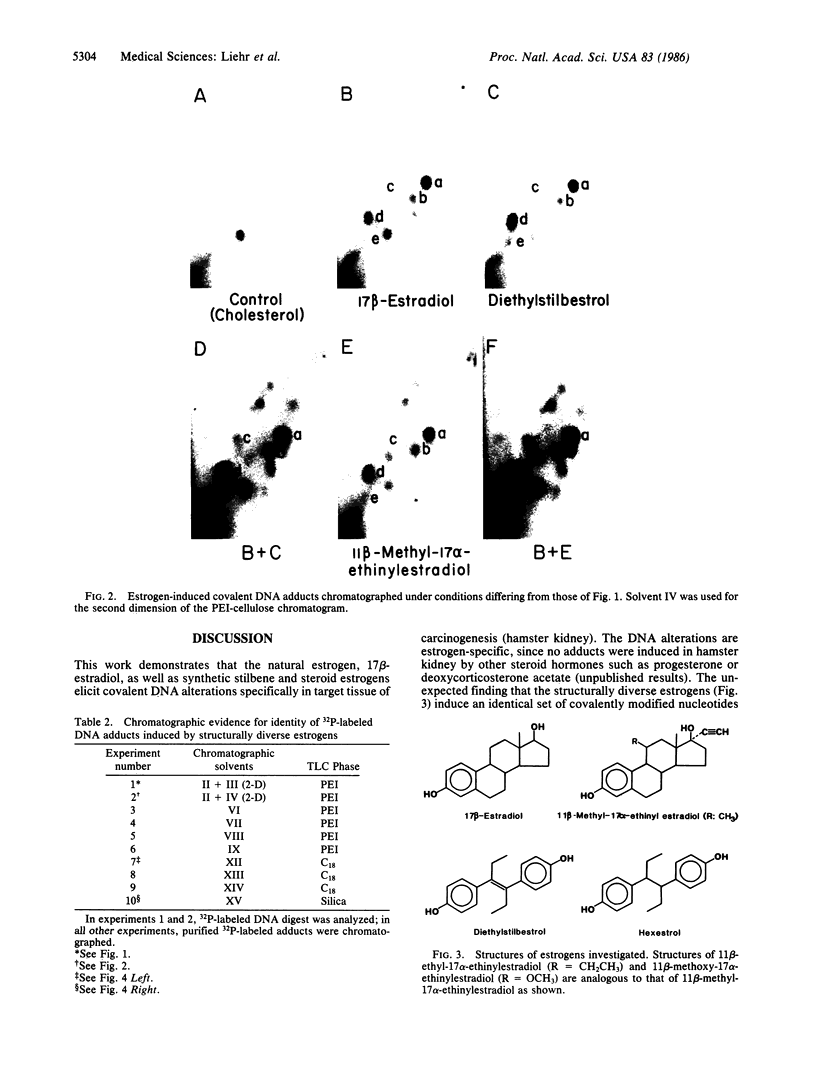
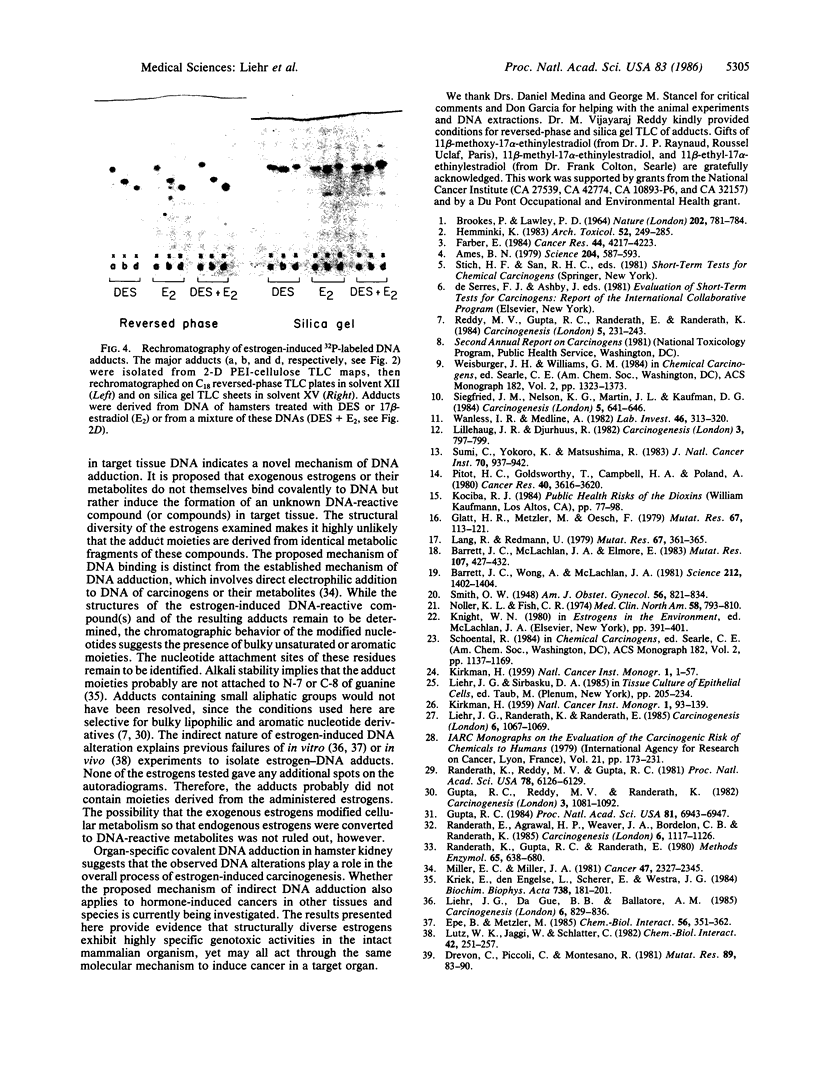
Images in this article
Selected References
These references are in PubMed. This may not be the complete list of references from this article.
- Ames B. N. Identifying environmental chemicals causing mutations and cancer. Science. 1979 May 11;204(4393):587–593. doi: 10.1126/science.373122. [DOI] [PubMed] [Google Scholar]
- BROOKES P., LAWLEY P. D. EVIDENCE FOR THE BINDING OF POLYNUCLEAR AROMATIC HYDROCARBONS TO THE NUCLEIC ACIDS OF MOUSE SKIN: RELATION BETWEEN CARCINOGENIC POWER OF HYDROCARBONS AND THEIR BINDING TO DEOXYRIBONUCLEIC ACID. Nature. 1964 May 23;202:781–784. doi: 10.1038/202781a0. [DOI] [PubMed] [Google Scholar]
- Barrett J. C., McLachlan J. A., Elmore E. Inability of diethylstilbestrol to induce 6-thioguanine-resistant mutants and to inhibit metabolic cooperation of V79 Chinese hamster cells. Mutat Res. 1983 Feb;107(2):427–432. doi: 10.1016/0027-5107(83)90181-1. [DOI] [PubMed] [Google Scholar]
- Barrett J. C., Wong A., McLachlan J. A. Diethylstilbestrol induces neoplastic transformation without measurable gene mutation at two loci. Science. 1981 Jun 19;212(4501):1402–1404. doi: 10.1126/science.6262919. [DOI] [PubMed] [Google Scholar]
- Drevon C., Piccoli C., Montesano R. Mutagenicity assays of estrogenic hormones in mammalian cells. Mutat Res. 1981 May;89(1):83–90. doi: 10.1016/0165-1218(81)90134-8. [DOI] [PubMed] [Google Scholar]
- Epe B., Metzler M. Nature of the macromolecular binding of diethylstilbestrol to DNA and protein following oxidation by peroxidase/hydrogen peroxide. Chem Biol Interact. 1985 Dec 31;56(2-3):351–361. doi: 10.1016/0009-2797(85)90016-x. [DOI] [PubMed] [Google Scholar]
- Farber E. The multistep nature of cancer development. Cancer Res. 1984 Oct;44(10):4217–4223. [PubMed] [Google Scholar]
- Glatt H. R., Metzler M., Oesch F. Diethylstilbestrol and 11 derivatives: a mutagenicity study with Salmonella typhimurium. Mutat Res. 1979 Jun;67(2):113–121. doi: 10.1016/0165-1218(79)90122-8. [DOI] [PubMed] [Google Scholar]
- Gupta R. C. Nonrandom binding of the carcinogen N-hydroxy-2-acetylaminofluorene to repetitive sequences of rat liver DNA in vivo. Proc Natl Acad Sci U S A. 1984 Nov;81(22):6943–6947. doi: 10.1073/pnas.81.22.6943. [DOI] [PMC free article] [PubMed] [Google Scholar]
- Gupta R. C., Reddy M. V., Randerath K. 32P-postlabeling analysis of non-radioactive aromatic carcinogen--DNA adducts. Carcinogenesis. 1982;3(9):1081–1092. doi: 10.1093/carcin/3.9.1081. [DOI] [PubMed] [Google Scholar]
- Hemminki K. Nucleic acid adducts of chemical carcinogens and mutagens. Arch Toxicol. 1983 Apr;52(4):249–285. doi: 10.1007/BF00316495. [DOI] [PubMed] [Google Scholar]
- KIRKMAN H. Estrogen-induced tumors of the kidney. III. Growth characteristics in the Syrian hamster. Natl Cancer Inst Monogr. 1959 Dec;1:1–57. [PubMed] [Google Scholar]
- KIRKMAN H., ROBBINS M. Estrogen-induced tumors of the kidney. V. Histology and histogenesis in the Syrian hamster. Natl Cancer Inst Monogr. 1959 Dec;1:93–139. [PubMed] [Google Scholar]
- Kriek E., Den Engelse L., Scherer E., Westra J. G. Formation of DNA modifications by chemical carcinogens. Identification, localization and quantification. Biochim Biophys Acta. 1984;738(4):181–201. doi: 10.1016/0304-419x(83)90003-3. [DOI] [PubMed] [Google Scholar]
- Lang R., Redmann U. Non-mutagenicity of some sex hormones in the Ames salmonella/microsome mutagenicity test. Mutat Res. 1979 Aug;67(4):361–365. doi: 10.1016/0165-1218(79)90033-8. [DOI] [PubMed] [Google Scholar]
- Liehr J. G., DaGue B. B., Ballatore A. M. Reactivity of 4',4"-diethylstilbestrol quinone, a metabolic intermediate of diethylstilbestrol. Carcinogenesis. 1985 Jun;6(6):829–836. doi: 10.1093/carcin/6.6.829. [DOI] [PubMed] [Google Scholar]
- Liehr J. G., Randerath K., Randerath E. Target organ-specific covalent DNA damage preceding diethylstilbestrol-induced carcinogenesis. Carcinogenesis. 1985 Jul;6(7):1067–1069. doi: 10.1093/carcin/6.7.1067. [DOI] [PubMed] [Google Scholar]
- Lillehaug J. R., Djurhuus R. Effect of diethylstilbestrol on the transformable mouse embryo fibroblast C3H/10T1/2C18 cells. Tumor promotion, cell growth, DNA synthesis, and ornithine decarboxylase. Carcinogenesis. 1982;3(7):797–799. doi: 10.1093/carcin/3.7.797. [DOI] [PubMed] [Google Scholar]
- Lutz W. K., Jaggi W., Schlatter C. Covalent binding of diethylstilbestrol to DNA in rat and hamster liver and kidney. Chem Biol Interact. 1982 Nov;42(2):251–257. doi: 10.1016/0009-2797(82)90136-3. [DOI] [PubMed] [Google Scholar]
- Miller E. C., Miller J. A. Searches for ultimate chemical carcinogens and their reactions with cellular macromolecules. Cancer. 1981 May 15;47(10):2327–2345. doi: 10.1002/1097-0142(19810515)47:10<2327::aid-cncr2820471003>3.0.co;2-z. [DOI] [PubMed] [Google Scholar]
- Noller K. L., Fish C. R. Diethylstilbestrol usage: Its interesting past, important present, and questionable future. Med Clin North Am. 1974 Jul;58(4):793–810. doi: 10.1016/s0025-7125(16)32122-8. [DOI] [PubMed] [Google Scholar]
- Pitot H. C., Goldsworthy T., Campbell H. A., Poland A. Quantitative evaluation of the promotion by 2,3,7,8-tetrachlorodibenzo-p-dioxin of hepatocarcinogenesis from diethylnitrosamine. Cancer Res. 1980 Oct;40(10):3616–3620. [PubMed] [Google Scholar]
- Randerath E., Agrawal H. P., Weaver J. A., Bordelon C. B., Randerath K. 32P-postlabeling analysis of DNA adducts persisting for up to 42 weeks in the skin, epidermis and dermis of mice treated topically with 7,12-dimethylbenz[a]anthracene. Carcinogenesis. 1985 Aug;6(8):1117–1126. doi: 10.1093/carcin/6.8.1117. [DOI] [PubMed] [Google Scholar]
- Randerath K., Gupta R. C., Randerath E. 3H and 32P derivative methods for base composition and sequence analysis of RNA. Methods Enzymol. 1980;65(1):638–680. doi: 10.1016/s0076-6879(80)65065-4. [DOI] [PubMed] [Google Scholar]
- Randerath K., Reddy M. V., Gupta R. C. 32P-labeling test for DNA damage. Proc Natl Acad Sci U S A. 1981 Oct;78(10):6126–6129. doi: 10.1073/pnas.78.10.6126. [DOI] [PMC free article] [PubMed] [Google Scholar]
- Reddy M. V., Gupta R. C., Randerath E., Randerath K. 32P-postlabeling test for covalent DNA binding of chemicals in vivo: application to a variety of aromatic carcinogens and methylating agents. Carcinogenesis. 1984 Feb;5(2):231–243. doi: 10.1093/carcin/5.2.231. [DOI] [PubMed] [Google Scholar]
- Siegfried J. M., Nelson K. G., Martin J. L., Kaufman D. G. Promotional effect of diethylstilbestrol on human endometrial stromal cells pretreated with a direct-acting carcinogen. Carcinogenesis. 1984 May;5(5):641–646. doi: 10.1093/carcin/5.5.641. [DOI] [PubMed] [Google Scholar]
- Sumi C., Yokoro K., Matsushima R. Induction of hepatic tumors by diethylstilbestrol alone or in synergism with n-nitrosobutylurea in castrated male WF rats. J Natl Cancer Inst. 1983 May;70(5):937–942. [PubMed] [Google Scholar]
- Wanless I. R., Medline A. Role of estrogens as promoters of hepatic neoplasia. Lab Invest. 1982 Mar;46(3):313–320. [PubMed] [Google Scholar]








